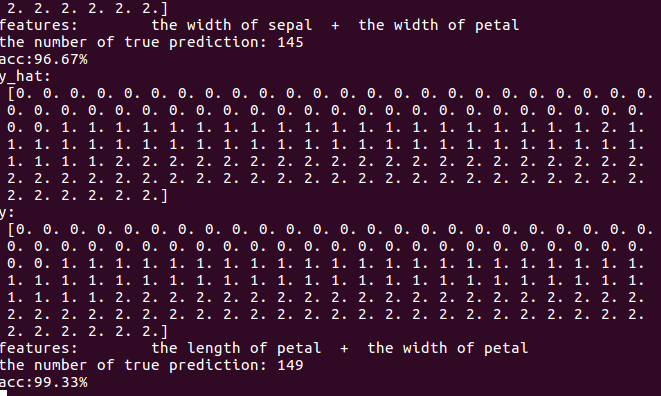code:
import numpy as np
import pandas as pd
import matplotlib.pyplot as plt
import matplotlib as mpl
from sklearn import tree
from sklearn.tree import DecisionTreeClassifier
from sklearn.model_selection import train_test_split
from sklearn.preprocessing import StandardScaler
from sklearn.pipeline import Pipeline
import pydotplus
if __name__ == "__main__":
iris_feature_E = "sepal lenght", "sepal width", "petal length", "petal width"
iris_feature = "the length of sepal", "the width of sepal", "the length of petal", "the width of petal"
iris_class = "Iris-setosa", "Iris-versicolor", "Iris-virginica"
data = pd.read_csv("iris.data", header=None)
iris_types = data[4].unique()
for i, type in enumerate(iris_types):
data.set_value(data[4] == type, 4, i)
x, y = np.split(data.values, (4,), axis=1)
x_train, x_test, y_train, y_test = train_test_split(x, y, train_size=0.7, random_state=1)
print(y_test)
model = DecisionTreeClassifier(criterion='entropy', max_depth=6)
model = model.fit(x_train, y_train)
y_test_hat = model.predict(x_test)
with open('iris.dot', 'w') as f:
tree.export_graphviz(model, out_file=f)
dot_data = tree.export_graphviz(model, out_file=None, feature_names=iris_feature_E, class_names=iris_class,
filled=True, rounded=True, special_characters=True)
graph = pydotplus.graph_from_dot_data(dot_data)
graph.write_pdf('iris.pdf')
f = open('iris.png', 'wb')
f.write(graph.create_png())
f.close()
# 画图
# 横纵各采样多少个值
N, M = 50, 50
# 第0列的范围
x1_min, x1_max = x[:, 0].min(), x[:, 0].max()
# 第1列的范围
x2_min, x2_max = x[:, 1].min(), x[:, 1].max()
t1 = np.linspace(x1_min, x1_max, N)
t2 = np.linspace(x2_min, x2_max, M)
# 生成网格采样点
x1, x2 = np.meshgrid(t1, t2)
# # 无意义,只是为了凑另外两个维度
# # 打开该注释前,确保注释掉x = x[:, :2]
x3 = np.ones(x1.size) * np.average(x[:, 2])
x4 = np.ones(x1.size) * np.average(x[:, 3])
# 测试点
x_show = np.stack((x1.flat, x2.flat, x3, x4), axis=1)
print("x_show_shape:\n", x_show.shape)
cm_light = mpl.colors.ListedColormap(['#77E0A0', '#FF8080', '#A0A0FF'])
cm_dark = mpl.colors.ListedColormap(['g', 'r', 'b'])
# 预测值
y_show_hat = model.predict(x_show)
print(y_show_hat.shape)
print(y_show_hat)
# 使之与输入的形状相同
y_show_hat = y_show_hat.reshape(x1.shape)
print(y_show_hat)
plt.figure(figsize=(15, 15), facecolor='w')
# 预测值的显示
plt.pcolormesh(x1, x2, y_show_hat, cmap=cm_light)
print(y_test)
print(y_test.ravel())
# 测试数据
plt.scatter(x_test[:, 0], x_test[:, 1], c=np.squeeze(y_test), edgecolors='k', s=120, cmap=cm_dark, marker='*')
# 全部数据
plt.scatter(x[:, 0], x[:, 1], c=np.squeeze(y), edgecolors='k', s=40, cmap=cm_dark)
plt.xlabel(iris_feature[0], fontsize=15)
plt.ylabel(iris_feature[1], fontsize=15)
plt.xlim(x1_min, x1_max)
plt.ylim(x2_min, x2_max)
plt.grid(True)
plt.title('yuanwei flowers regressiong with DecisionTree', fontsize=17)
plt.show()
# 训练集上的预测结果
y_test = y_test.reshape(-1)
print(y_test_hat)
print(y_test)
# True则预测正确,False则预测错误
result = (y_test_hat == y_test)
acc = np.mean(result)
print('accuracy: %.2f%%' % (100 * acc))
# 过拟合:错误率
depth = np.arange(1, 15)
err_list = []
for d in depth:
clf = DecisionTreeClassifier(criterion='entropy', max_depth=d)
clf = clf.fit(x_train, y_train)
# 测试数据
y_test_hat = clf.predict(x_test)
# True则预测正确,False则预测错误
result = (y_test_hat == y_test)
err = 1 - np.mean(result)
err_list.append(err)
print(d, 'error ratio: %.2f%%' % (100 * err))
plt.figure(figsize=(15, 15), facecolor='w')
plt.plot(depth, err_list, 'ro-', lw=2)
plt.xlabel('DecisionTree Depth', fontsize=15)
plt.ylabel('error ratio', fontsize=15)
plt.title('DecisionTree Depth and Overfit', fontsize=17)
plt.grid(True)
plt.show()
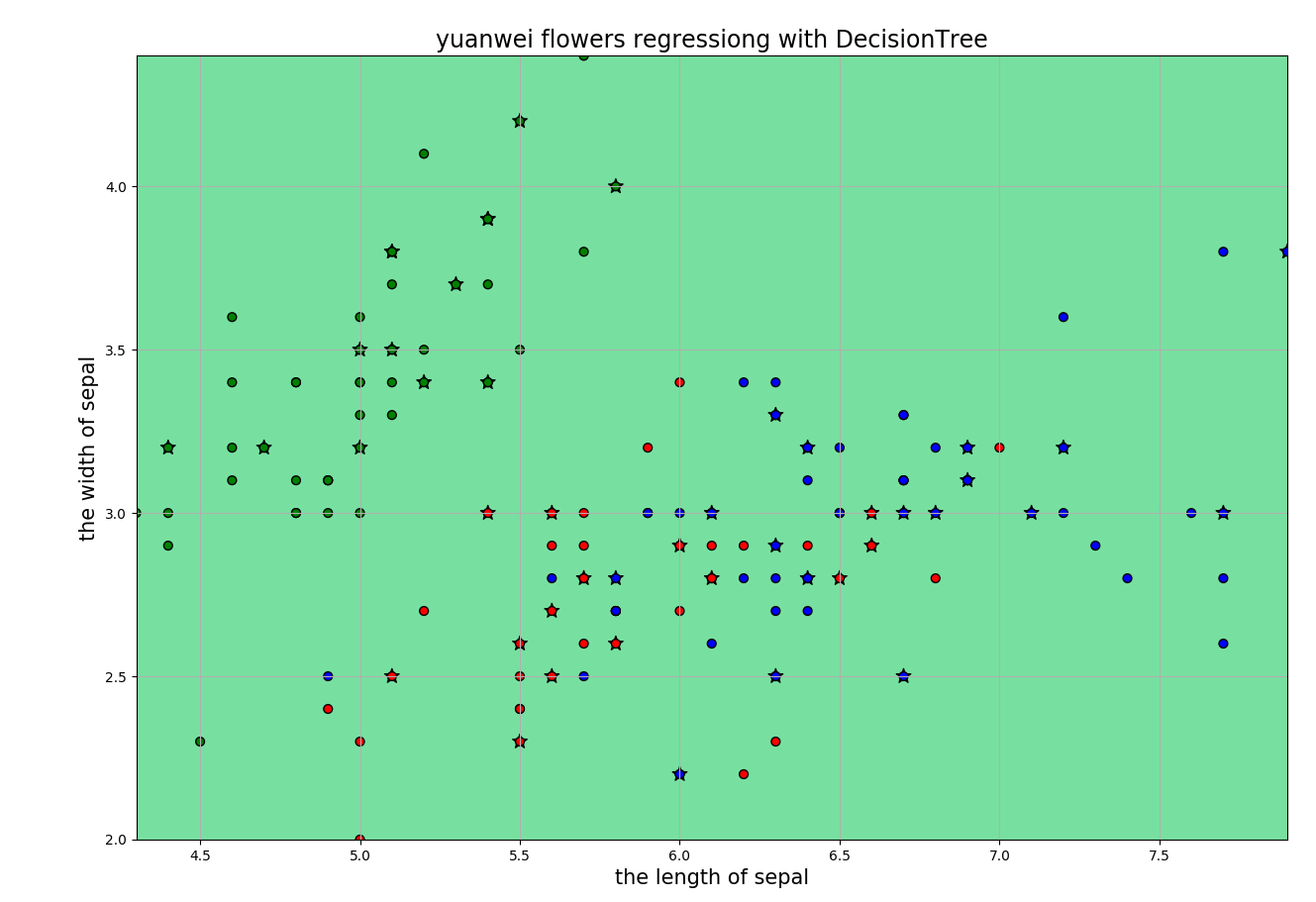


生成的图文件:
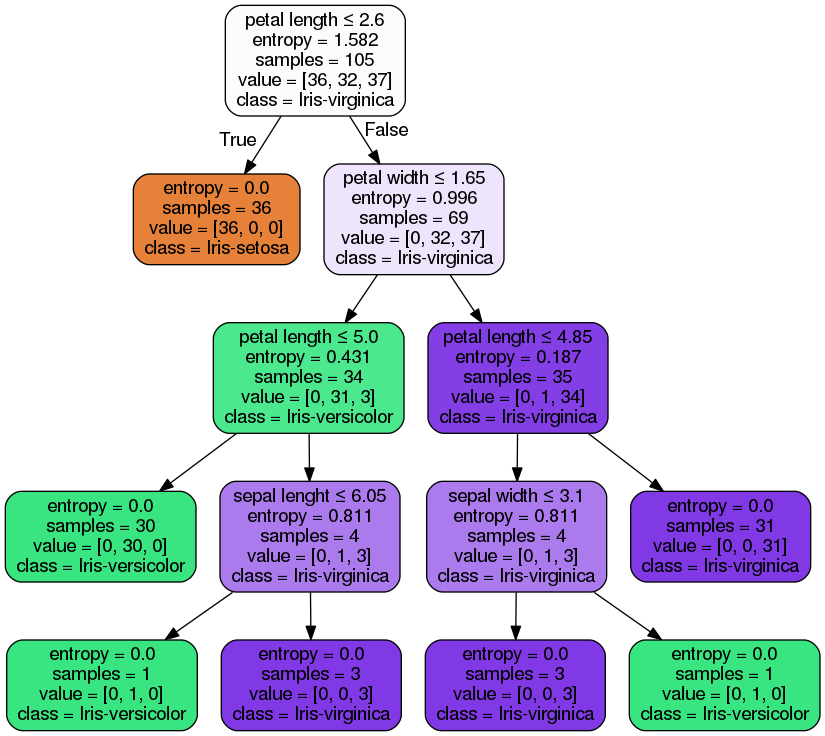
鸢尾花的数据特征一共有四种:花萼长度、花萼宽度,花瓣长度,花瓣宽度。然后再使用决策树两两特征进行分类:
import numpy as np
import pandas as pd
import matplotlib.pyplot as plt
import matplotlib as mpl
from sklearn import tree
from sklearn.tree import DecisionTreeClassifier
from sklearn.model_selection import train_test_split
from sklearn.preprocessing import StandardScaler
from sklearn.pipeline import Pipeline
import pydotplus
if __name__ == "__main__":
iris_feature_E = "sepal lenght", "sepal width", "petal length", "petal width"
iris_feature = "the length of sepal", "the width of sepal", "the length of petal", "the width of petal"
iris_class = "Iris-setosa", "Iris-versicolor", "Iris-virginica"
data = pd.read_csv("iris.data", header=None)
iris_types = data[4].unique()
for i, type in enumerate(iris_types):
data.set_value(data[4] == type, 4, i)
x_train, y = np.split(data.values, (4,), axis=1)
feature_pairs = [(0, 1), (0, 2), (0, 3), (1, 2), (1, 3), (2, 3)]
plt.figure(figsize=(15, 15), facecolor='w')
for i, pair in enumerate(feature_pairs):
# 准备数据
x = x_train[:, pair]
# 决策树进行学习
clf = DecisionTreeClassifier(criterion='entropy', min_samples_leaf=3)
dt_clf = clf.fit(x, y)
# 开始画图
N, M = 500, 500
# 第0列的范围
x1_min, x1_max = x[:, 0].min(), x[:, 0].max()
# 第1列的范围
x2_min, x2_max = x[:, 1].min(), x[:, 1].max()
t1 = np.linspace(x1_min, x1_max, N)
t2 = np.linspace(x2_min, x2_max, M)
# 生成网格采样点
x1, x2 = np.meshgrid(t1, t2)
# 测试点
x_test = np.stack((x1.flat, x2.flat), axis=1)
# 在训练集上预测结果
y_hat = dt_clf.predict(x)
y = y.reshape(-1)
# 统计预测正确的个数
c = np.count_nonzero(y_hat == y)
print("y_hat:\n", y_hat)
print("y:\n", y)
'''
set1 = set(y_hat)
set2 = set(y)
print(list(set1 & set2))
if y_hat.any() != y.any():
print('predict:%.3f real:%.3f' %(y_hat.all(), y.all()))
'''
# 打印相关信息
print('features:\t', iris_feature[pair[0]], ' + ', iris_feature[pair[1]])
print('the number of true prediction:', c)
print('acc:%.2f%%' %(100 * float(c) / float(len(y))))
# 画图显示
cm_light = mpl.colors.ListedColormap(['#77E0A0', '#FF8080', '#A0A0FF'])
cm_dark = mpl.colors.ListedColormap(['g', 'r', 'b'])
# 预测值
y_test_hat = dt_clf.predict(x_test)
# reshape到和输入的x1相同格式
y_test_hat = y_test_hat.reshape(x1.shape)
plt.subplot(2, 3, i+1)
plt.pcolormesh(x1, x2, y_test_hat, cmap=cm_light)
plt.scatter(x[:, 0], x[:, 1], c=y, edgecolors='k', cmap=cm_dark)
plt.xlabel(iris_feature[pair[0]], fontsize=14)
plt.ylabel(iris_feature[pair[1]], fontsize=14)
plt.xlim(x1_min, x1_max)
plt.ylim(x2_min, x2_max)
plt.grid()
plt.suptitle('the result of yuanwei flowers in each two features with dcisiontree', fontsize=20)
plt.tight_layout(2)
plt.subplots_adjust(top=0.92)
plt.show()
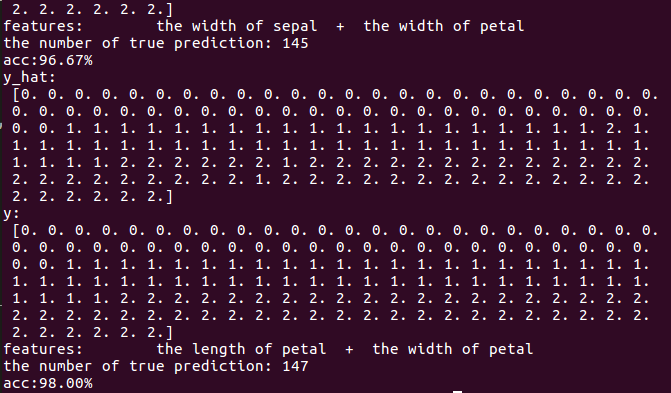
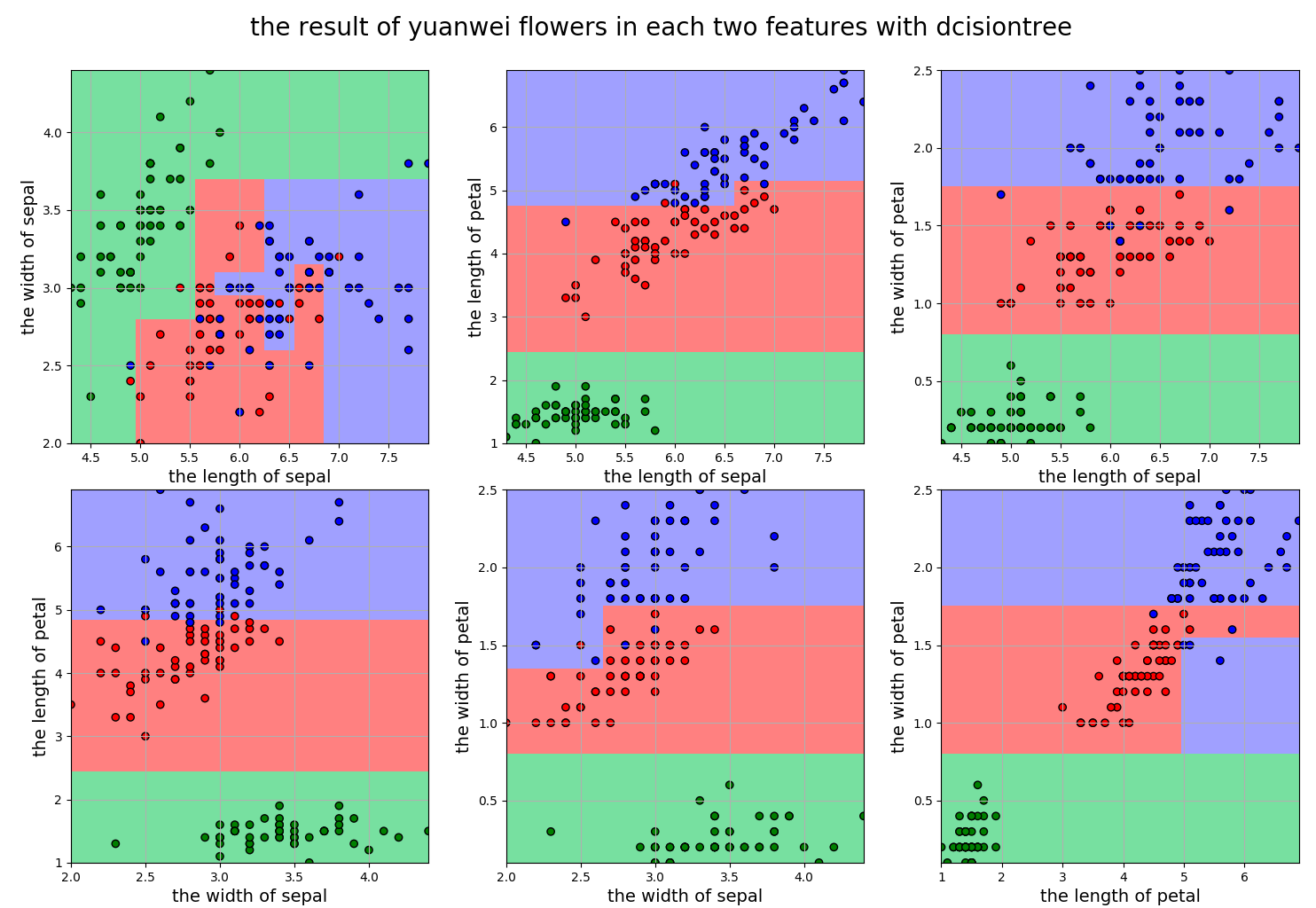
显然第二种组合效果还可以的。
接着我们使用随机森林算法来分类看看效果:
只需要在上面的代码中修改:
# 决策树进行学习
clf = DecisionTreeRegressor(n_estimators=200, criterion='entropy', max_depth=6)
为:
# 决策树进行学习
clf = RandomForestClassifier(n_estimators=200, criterion='entropy', max_depth=6)
效果:
看得出来随机森林的分类要比决策树好,随机森林因为是根据多个决策树弱分类器联合成一个强分类器,所以其边界出呈现很多的锯齿,分类的准确度也提高很多,150个数据,最后只有一个分错。
